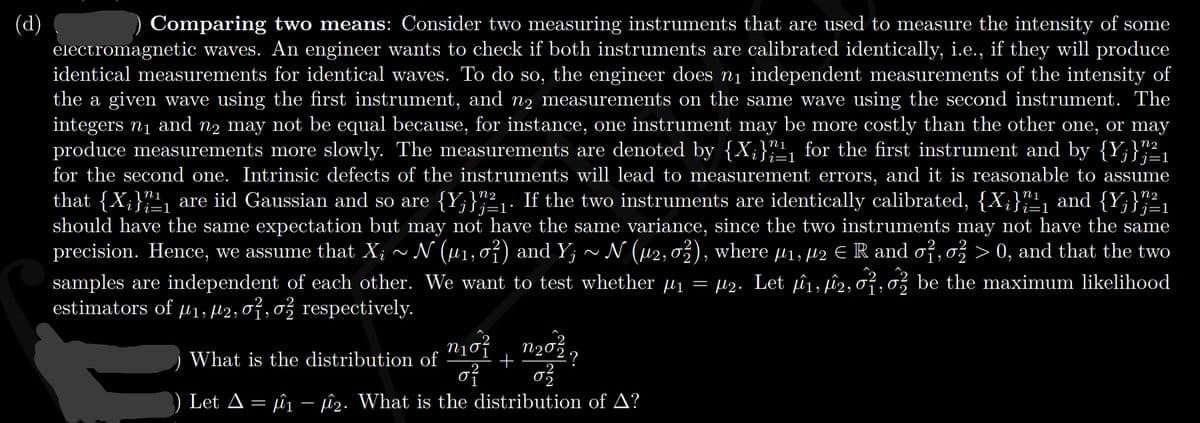al measurements for identical waves. To do so, the engineer de iven wave using the first instrument, and n2 measurements c sni and n2 may not be equal because, for instance, one instru e measurements more slowly. The measurements are denoted second one. Intrinsic defects of the instruments will lead to X;}"', are iid Gaussian and so are {Y;}"21. If the two instrum have the same expectation but may not have the same varian on. Hence, we assume that X; ~ N (u1,o?) and Y, ~N (u2,o:
al measurements for identical waves. To do so, the engineer de iven wave using the first instrument, and n2 measurements c sni and n2 may not be equal because, for instance, one instru e measurements more slowly. The measurements are denoted second one. Intrinsic defects of the instruments will lead to X;}"', are iid Gaussian and so are {Y;}"21. If the two instrum have the same expectation but may not have the same varian on. Hence, we assume that X; ~ N (u1,o?) and Y, ~N (u2,o:
Algebra & Trigonometry with Analytic Geometry
13th Edition
ISBN:9781133382119
Author:Swokowski
Publisher:Swokowski
Chapter5: Inverse, Exponential, And Logarithmic Functions
Section5.6: Exponential And Logarithmic Equations
Problem 64E
Related questions
Topic Video
Question
Please do the attached question (explained please) thanks

Transcribed Image Text:(d)
electromagnetic waves. An engineer wants to check if both instruments are calibrated identically, i.e., if they will produce
identical measurements for identical waves. To do so, the engineer does nį independent measurements of the intensity of
the a given wave using the first instrument, and n2 measurements on the same wave using the second instrument. The
integers n1 and n2 may not be equal because, for instance, one instrument may be more costly than the other one, or may
produce measurements more slowly. The measurements are denoted by {X;}"1, for the first instrument and by {Y;}"2,
for the second one. Intrinsic defects of the instruments will lead to measurement errors, and it is reasonable to assume
that {X;}""1 are iid Gaussian and so are {Y;}",²1. If the two instruments are identically calibrated, {X;}""1 and {Y;}";²1
should have the same expectation but may not have the same variance, since the two instruments may not have the same
precision. Hence, we assume that X; ~ N (µ1, 0ỉ) and Y; ~ N (µ2,0), where µ1, H2 E R and of, o
samples are independent of each other. We want to test whether µ1 = µ2. Let pû1, pû2, o²,o be the maximum likelihood
estimators of µ1; µ2; 07,0% respectively.
Comparing two means: Consider two measuring instruments that are used to measure the intensity of some
i=1
ISj=1
Si=1
> 0, and that the two
n202?
What is the distribution of
of
Let A = ûj – û2. What is the distribution of A?
Expert Solution
This question has been solved!
Explore an expertly crafted, step-by-step solution for a thorough understanding of key concepts.
Step by step
Solved in 2 steps

Knowledge Booster
Learn more about
Need a deep-dive on the concept behind this application? Look no further. Learn more about this topic, statistics and related others by exploring similar questions and additional content below.Recommended textbooks for you

Algebra & Trigonometry with Analytic Geometry
Algebra
ISBN:
9781133382119
Author:
Swokowski
Publisher:
Cengage

Mathematics For Machine Technology
Advanced Math
ISBN:
9781337798310
Author:
Peterson, John.
Publisher:
Cengage Learning,

Trigonometry (MindTap Course List)
Trigonometry
ISBN:
9781337278461
Author:
Ron Larson
Publisher:
Cengage Learning

Algebra & Trigonometry with Analytic Geometry
Algebra
ISBN:
9781133382119
Author:
Swokowski
Publisher:
Cengage

Mathematics For Machine Technology
Advanced Math
ISBN:
9781337798310
Author:
Peterson, John.
Publisher:
Cengage Learning,

Trigonometry (MindTap Course List)
Trigonometry
ISBN:
9781337278461
Author:
Ron Larson
Publisher:
Cengage Learning